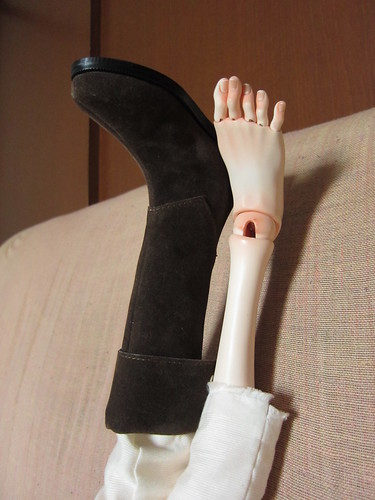which may facilitate the capture of microtubules emanating from poles in yeast. Laterally attached yeast kinetochores are subsequently transported poleward by motor proteins and regulators where they become attached to the end of microtubules . Although motor-driven transport toward the pole is often slower than microtubule disassembly, the kinetochores do not detach from  the microtubules. Instead, the kinetochore either establishes an end-on attachment when it meets the microtubule or else it promotes rescue of the shrinking microtubule. In this way, the kinetochore ensures that it stays bound until a proper end-on attachment can be achieved. Rescue is mediated by the Stu2 protein, which binds to tubulin dimers via TOG domains and facilitates microtubule growth that emanate from the spindle pole bodies. The nucleus is shown in blue with SPBs embedded in its PubMed ID:http://www.ncbi.nlm.nih.gov/pubmed/19796427 nuclear envelope and the kinetochores on the chromosomes are shown in red. tension prolongs the lifetime of kinetochoremicrotubule interactions in vitro, suggesting that tension directly RS 1 web stabilizes microtubule attachments. Elegant computer modeling supports the role of tension in stabilizing attachments. Once all kinetochores biorient, the cohesin between sisters is cleaved, allowing the chromosomes to be separated and moved to the poles at anaphase. If even a single pair of chromosomes lacks tension or attachment, a signal transduction system called the spindle checkpoint prevents anaphase. To date, it is still controversial whether there is a single upstream signal that triggers the checkpoint or whether tension and attachment are separately monitored. Huffaker 1997; Al-Bassam et al. 2006; Brouhard et al. 2008). Stu2 also helps kinetochores nucleate microtubules, a feature that appears to help establish lateral attachments through microtubulemicrotubule interactions that are eventually converted to plus end attachments at the kinetochores. Once the kinetochores travel back to the pole, the sister kinetochores make bioriented attachments to the tips of microtubules and come under tension due to pulling forces that are opposed by the linkage between the sisters. The kinetochores then maintain persistent load-bearing attachments to the continually growing and shrinking tips of the microtubules. Assays to study yeast chromosome segregation Cytological assays Establishing kinetochore biorientation The process of making bioriented kinetochoremicrotubule attachments is inherently error prone. Kinetochores can make syntelic attachments where both sisters attach to microtubules from the same pole or monotelic attachments in which one of the two sister kinetochores attaches to a microtubule from one pole. Most eukaryotic kinetochores can also make merotelic attachments where a single kinetochore binds to microtubules from both poles, but this is not possible in budding yeast where there is only one microtubule-binding site on each kinetochore. Because syntelic or monooriented attachments will lead to errors in segregation, the cell has mechanisms to detect and correct inappropriate microtubule attachments. A variety of evidence suggests that the cell monitors the tension generated when sister kinetochores achieve biorientation. When kinetochores lack tension, the conserved Aurora B protein kinase phosphorylates kinetochore proteins, leading to their release from microtubules so the cell can attempt biorientation again. In addition, Historically, one of the greatest difficulties in studying
the microtubules. Instead, the kinetochore either establishes an end-on attachment when it meets the microtubule or else it promotes rescue of the shrinking microtubule. In this way, the kinetochore ensures that it stays bound until a proper end-on attachment can be achieved. Rescue is mediated by the Stu2 protein, which binds to tubulin dimers via TOG domains and facilitates microtubule growth that emanate from the spindle pole bodies. The nucleus is shown in blue with SPBs embedded in its PubMed ID:http://www.ncbi.nlm.nih.gov/pubmed/19796427 nuclear envelope and the kinetochores on the chromosomes are shown in red. tension prolongs the lifetime of kinetochoremicrotubule interactions in vitro, suggesting that tension directly RS 1 web stabilizes microtubule attachments. Elegant computer modeling supports the role of tension in stabilizing attachments. Once all kinetochores biorient, the cohesin between sisters is cleaved, allowing the chromosomes to be separated and moved to the poles at anaphase. If even a single pair of chromosomes lacks tension or attachment, a signal transduction system called the spindle checkpoint prevents anaphase. To date, it is still controversial whether there is a single upstream signal that triggers the checkpoint or whether tension and attachment are separately monitored. Huffaker 1997; Al-Bassam et al. 2006; Brouhard et al. 2008). Stu2 also helps kinetochores nucleate microtubules, a feature that appears to help establish lateral attachments through microtubulemicrotubule interactions that are eventually converted to plus end attachments at the kinetochores. Once the kinetochores travel back to the pole, the sister kinetochores make bioriented attachments to the tips of microtubules and come under tension due to pulling forces that are opposed by the linkage between the sisters. The kinetochores then maintain persistent load-bearing attachments to the continually growing and shrinking tips of the microtubules. Assays to study yeast chromosome segregation Cytological assays Establishing kinetochore biorientation The process of making bioriented kinetochoremicrotubule attachments is inherently error prone. Kinetochores can make syntelic attachments where both sisters attach to microtubules from the same pole or monotelic attachments in which one of the two sister kinetochores attaches to a microtubule from one pole. Most eukaryotic kinetochores can also make merotelic attachments where a single kinetochore binds to microtubules from both poles, but this is not possible in budding yeast where there is only one microtubule-binding site on each kinetochore. Because syntelic or monooriented attachments will lead to errors in segregation, the cell has mechanisms to detect and correct inappropriate microtubule attachments. A variety of evidence suggests that the cell monitors the tension generated when sister kinetochores achieve biorientation. When kinetochores lack tension, the conserved Aurora B protein kinase phosphorylates kinetochore proteins, leading to their release from microtubules so the cell can attempt biorientation again. In addition, Historically, one of the greatest difficulties in studying